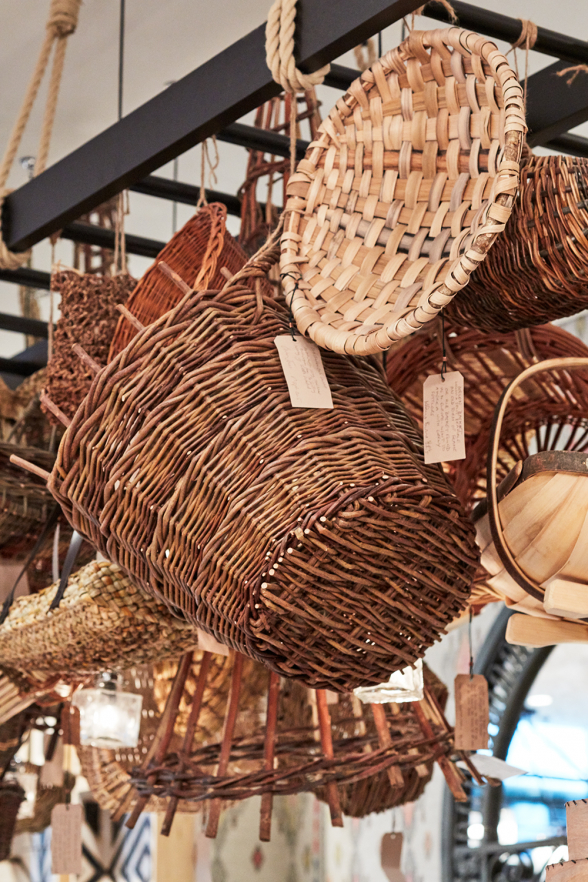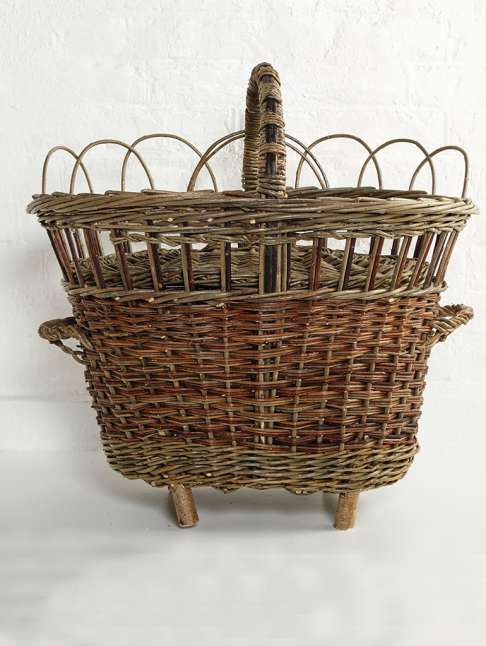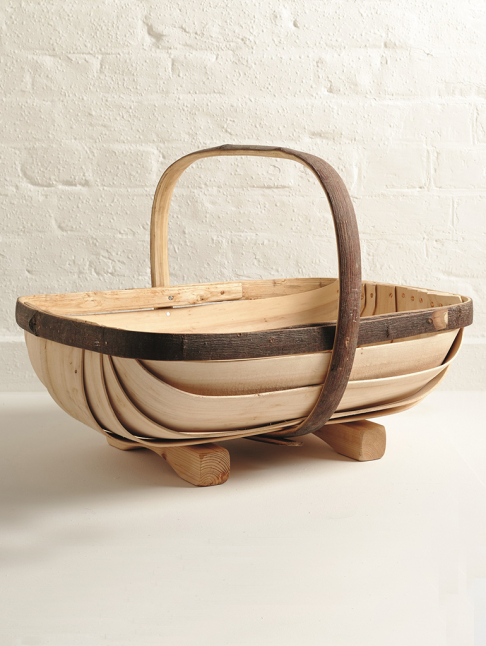A New York hotel celebrates the skill and romance of Britain’s old-time basketweavers
One thing the Firmdale Hotels have in common is the intoxicating collision of contemporary art, patterns and textiles. But you can always count on hotelier Kit Kemp to imbue each member of her 10-strong portfolio with a cheeky point of difference. In London, the Ham Yard has a theatre, a bowling alley, and a garden on the roof, Haymarket and Soho turn tailors’ dummies into decor, and, in Manhattan, Crosby Street Hotel shouts out its love for pets with sculptures you want to pat. The newest of the NYC portfolio, the Whitby, has a bar installation that pays homage to Britain’s basket-weavers down the centuries.
Each basket in the collection originates from parts of England, Scotland, Ireland and Wales, and was designed for a specific purpose – whether to hold newly harvested potatoes, oysters, flowers, tools, or the family tea-set.

Up close: Baskets of Britain, fit for purpose
Says Kemp, “Each design has been put to work on a daily basis and the design has never needed to change or to be updated for hundreds of years … plastic bags and polystyrene trays do not have the same romance.”
The installation is a celebration of craftsmanship. It owes its existence to The Baskets of Britain, a project by The New Craftsmen, a London-based gallery and furniture store representing the exceptional work of craftsmen and craftswomen from all over the British Isles, whether it be in furniture, lighting or textiles.
The New Craftsmen called in master basket-maker Hilary Burns to facilitate a collaboration with 20 basket-makers in creating examples that reflected regional idiosyncrasies.
In a booklet to explain the project, Catherine Lock, the creative director of The New Craftsmen, says: “Months of research and development resulted in an installation of 52 baskets in 22 varieties using different materials and weave structures – from the coiled baskets of the Scottish Shetlands to the trugs of Sussex, South England.
These were some that caught the attention of Excess All Areas, and are elaborated upon in Baskets of Britain.

Basket used for selling flowers in Victorian England
Flower seller’s basket
Stocks, moss roses, primroses, violets and lavender …. posies were carried about – often by young girls – in these Victorian-era baskets. They were a useful way to avoid paying “stallage”, a tax on fixed premises. There’s a false bottom in the middle that lifts out to allow extra flowers to be kept in the cool darkness. The four stout feet enabled airflow and kept the flowers out of the mud during a transaction. Maker: Hilary Burns

Northumbrian Fishwife’s Creel, the era’s utility shoulder bag
Northumbrian Fishwife’s Creel
Characteristic of the northern and western fringes of the British Isles, this basket originated on the Cumberland coast where it was used by fishermen’s wives to cart the day’s catch. The open bottom design made it more comfortable to be carried on one shoulder. The basket-maker inserts stakes into the ground and then weaves around them to form the sides. To stop the weave from slipping once the stake is removed, makers employ what’s called a mouthwale weave, a very tight weave used in the first round of waving, i.e. close to the ground. Maker: Liz Balfour

Sussex Trug – originally used to measure grain and liquids
Sussex Trug
Trugs were used by Sussex farmers to gauge grains and liquids and were made in several sizes, for different measures, until the mid 1600s. It was a redesign of the historic trog, a wooden vessel hewed from solid timber in the shape of a round coracle boat. The modern version is the Sussex Trug, invented in the 1820s by Thomas Smith of Herstmonceaux. In 1851, Smith showed his more lightweight Sussex Trug at The Great Exhibition where it caught the eye of Queen Victoria who bought them as gifts, and then gifted Smith royal patronage for his efforts. It remains popular today with British gardeners. It has a handle and rim of coppiced sweet chestnut wood; the body is made of five or seven thin boards of cricket bat willow, hand-shaved with a drawknife. Maker: Cuckmere Trug Co.
The New Craftsmen has a selection of baskets available to purchase in-store (London) or online.
The New Craftsmen: 34 North Row, Mayfair, London W1K 6DG; thenewcraftsmen.com
The Whitby Bar & Restaurant, Whitby Hotel, 18 W 56th Street, New York, NY 10019, firmdalehotels.com
Images used with permission of Firmdale Hotels







'Basket case | Setting the bar high | weaving magic' has no comments
Be the first to comment this post!